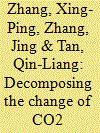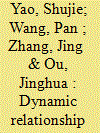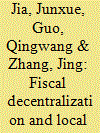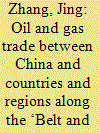|
|
|
Sort Order |
|
|
|
Items / Page
|
|
|
|
|
|
|
| Srl | Item |
| 1 |
ID:
122742


|
|
|
|
|
| Publication |
2013.
|
| Summary/Abstract |
This paper presents an alternative decomposition method to explore the driving forces of change in carbon emissions by using distance functions estimated by data envelopment analysis. The proposed approach can isolate the effects of changes in GDP composition and energy supply composition on the change of carbon emissions. In addition, it is capable of identifying the effects of changes in different input ratios, which may be very important if there are substitution effects among different inputs. Moreover, the proposed model can measure the effects of changes in good and bad output technical efficiencies. Consequently, this decomposition technique allows a change of carbon emissions to be decomposed into contributions from ten factors, which provides more insights for policy makers. We apply this model to decompose carbon emissions in 25 OECD counties and China. For the sample countries as a whole, the empirical results indicate that the economic growth is the crucial driver to carbon emissions increase, while the changes in GDP composition and capital-energy ratio are two main drivers to carbon emissions reduction. In particular, we discuss in detail the driving forces of China's carbon emissions change in order to propose some valuable policy implications for China from an international perspective.
|
|
|
|
|
|
|
|
|
|
|
|
|
|
|
|
| 2 |
ID:
147614


|
|
|
|
|
| Summary/Abstract |
This paper studies the dynamic relationship of China's inward and outward foreign direct investments (FDI). It first identifies the key determinants of China's outward FDI (OFDI) in 172 host countries during 2003–2009 using a partial stock adjustment model. It finds strong evidence of dynamic adjustment in China's OFDI stock with an agglomeration effect. The dynamic adjustment and agglomeration effects are stronger in “high-tech” countries than in “low-tech” ones but indifferent in host country's resource endowments and income levels. The empirical results suggest that there exists a substantial adjustment cost in China's OFDI and that China's existing OFDI stock can gradually adjust toward its long-term equilibrium level, which is not only greater but also more volatile than the actual stock. Of particular interest is that we find a strong and positive relationship between lagged inward FDI (IFDI) and contemporaneous OFDI, implying that capital outflow from China has been partially induced by the countries which have invested in China.
|
|
|
|
|
|
|
|
|
|
|
|
|
|
|
|
| 3 |
ID:
130541


|
|
|
|
|
| Publication |
2014.
|
| Summary/Abstract |
Since the tax-sharing reform in 1994, the Chinese fiscal system has exhibited a marked vertical fiscal imbalance-a mismatch between expenditure and revenue assignments-at the local levels, which may cause the common-pool problem in local governments' behavior. Using a large fiscal dataset at the county level from 1997 to 2006, this paper studies the effects of fiscal decentralization on local expenditure policy and analyzes how the vertical fiscal imbalance shapes these effects. The estimation results show that expenditure decentralization increases government spending and leads to a fund allocation with a larger weight on capital construction and smaller weights on education and administration. In contrast, revenue decentralization has little influence on local government expenditures. We show that the differences in the effects of expenditure and revenue decentralization can be attributed to the distortionary effects caused by the vertical fiscal imbalance and, thus, offer support to the importance of the common-pool problem at the county level of China's fiscal system.
|
|
|
|
|
|
|
|
|
|
|
|
|
|
|
|
| 4 |
ID:
134860


|
|
|
|
|
| Summary/Abstract |
Using a sample of 1185 households in 48 Chinese villages for the period 1987–2002, we study the effects of major health shocks on household income and the role played by village elections in mitigating these effects. Major health shocks are defined by abnormal increases in a household's medical expenditure. Our results show that a major health shock reduces households' net income significantly and that village elections alleviate such adverse impacts by almost half. The main mechanism behind this effect is increased coverage of health care insurance, which helps households smooth their consumption when major health shocks happen.
|
|
|
|
|
|
|
|
|
|
|
|
|
|
|
|
| 5 |
ID:
191148


|
|
|
|
|
| Summary/Abstract |
We build a simple overlapping generation model to investigate the effect of life expectancy on the real exchange rate where fertility is chosen endogenously. The model reveals that, although the overall effect of life expectancy on the real exchange rate is not certain, longer life expectancy tends to cause the real exchange rate to depreciate by reducing fertility. Fertility thus serves as a mediator in the effect of life expectancy on the real exchange rate. Evidence from 148 economies (1980–2018) shows a statistically significant and robust negative relationship between life expectancy and the real exchange rate. It is estimated that a 1 year increase in life expectancy is associated with a 1.5 percent depreciation in the real exchange rate. The evidence also confirms the mediated effect of fertility. The mediated effect that fertility exerts accounts for 30 percent to 50 percent of the total effect, depending on the real exchange rate index used.
|
|
|
|
|
|
|
|
|
|
|
|
|
|
|
|
| 6 |
ID:
170192


|
|
|
|
|
| Summary/Abstract |
Because of the heavy burden that the resolution of social conflicts imposes on the Chinese government, the government is motivated to delegate or shift its conflict resolution responsibilities to specialized institutions, including social organizations. However, the effectiveness of responsibility shifting is conditional on the types of conflict and social contexts. Focusing on the resolution of medical disputes in China, this article examines the conditions under which the government can avoid direct and heavy involvement in dispute resolution. The government can effectively delegate the responsibility for resolving conflicts when the disputing parties perceive the mediation agencies as impartial. Having effective institutions thus limits government intervention to only a small number of disputes. This study is based on an analysis of 1351 medical disputes and about 80 interviews with parties involved in dispute resolution.
|
|
|
|
|
|
|
|
|
|
|
|
|
|
|
|
| 7 |
ID:
166480


|
|
|
|
|
| Summary/Abstract |
A stable and secure oil supply is essential to achieve sustainable development in China. The country mostly imports oil and gas from countries along the ‘Belt and Road’, which are major destination countries for the export of Chinese-manufactured products. Strengthening trade with these countries is essential to not only secure China's oil and gas supply but also promote development in the area. Based on the global commodity chain and value chain concepts, this paper analyses the status and prospects of the oil and gas trade between countries, considering all trade relations, which avoids the one-sidedness of oil and gas trade analysis based on the demand–supply relationship. We find that the general trade relationship between China and the countries along the Belt and Road is closely related to their oil and gas trade. Oil and gas resources are the main commodities exported to China by countries and regions having close trade relationships with it. Chinese policies should thus focus on developing the oil and gas trade with central Asia and Mongolia and improving the country's competitive advantage in traditional manufacturing exports, which, in turn, can enhance its position in international oil and gas trade.
|
|
|
|
|
|
|
|
|
|
|
|
|
|
|
|
| 8 |
ID:
108125


|
|
|
|
|
| Publication |
2011.
|
| Summary/Abstract |
In recent years China and India have achieved tremendous technological progress and development in the solar photovoltaic (PV) industry. Using case studies, this paper analyses and compares the technology progress in the solar PV industry in China and India, and discusses the role national innovation systems played in sustaining technology acquisition, adaptation and development. It illustrates that both countries adopted a strategy of mixing and sequencing different technology transfer and indigenous innovation mechanisms. The experience of both countries also suggests that a functional national environmental innovation system is important in sustaining and advancing technology acquisition, adaptation and development. This paper provides an alternative pathway for developing countries to follow in catching up with developed countries in the emergent green industries and in leapfrogging towards an internationally competitive green economy.
|
|
|
|
|
|
|
|
|
|
|
|
|
|
|
|
|
|
|
|
|